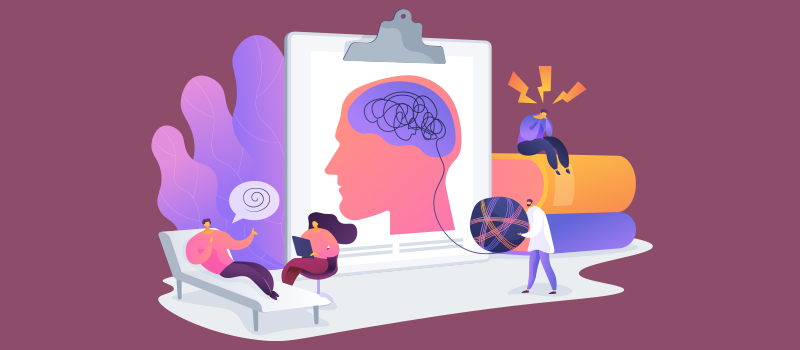Cognitive Behavioral Therapy (CBT) is a widely utilized, evidence-based therapeutic approach that focuses on the interplay between thoughts, feelings, and behaviors.
Its primary goal is to identify and challenge negative thought patterns and beliefs, thereby altering behaviors and emotional responses. Developed in the 1960s by Aaron T. Beck, CBT has evolved into one of the most effective treatments for a range of mental health disorders, particularly depression.
This article provides a comprehensive overview of CBT for depression, covering its theoretical foundations, mechanisms, techniques, and efficacy.
Theoretical Foundations
Cognitive Theory
Cognitive theory posits that our thoughts significantly influence our emotions and behaviors. Beck’s cognitive model suggests that dysfunctional thinking patterns contribute to the development and maintenance of depressive symptoms.
These maladaptive thoughts, or cognitive distortions, can include all-or-nothing thinking, overgeneralization, and catastrophizing.
Behavioral Theory
Behavioral theory, rooted in the principles of learning, emphasizes the role of environmental interactions in shaping behavior. It focuses on the concept of reinforcement and punishment
. In the context of depression, behaviors that reinforce negative thoughts and feelings are identified and modified.
The Cognitive-Behavioral Model
The cognitive-behavioral model integrates these two theories, proposing that changing maladaptive thoughts can lead to changes in emotions and behaviors.
It emphasizes the cyclical relationship between thoughts, feelings, and behaviors, suggesting that interventions can occur at any point in this cycle to disrupt the patterns maintaining depression.
Mechanisms of CBT for Depression
Identifying Negative Thought Patterns
One of the core mechanisms of CBT is identifying and challenging negative thought patterns. These thoughts, often automatic and pervasive, can perpetuate feelings of hopelessness and helplessness characteristic of depression.
Techniques such as thought records and cognitive restructuring help individuals recognize and modify these thoughts.
Behavioral Activation
Behavioral activation is a key component of CBT that involves increasing engagement in positively reinforcing activities.
This approach counteracts the withdrawal and inactivity often seen in depression, promoting a sense of accomplishment and pleasure.
Problem-Solving
CBT also emphasizes the development of problem-solving skills. Depressed individuals often feel overwhelmed by life’s challenges, leading to avoidance and exacerbation of depressive symptoms.
By enhancing problem-solving abilities, CBT helps individuals tackle issues more effectively, reducing feelings of helplessness.
Cognitive Restructuring
Cognitive restructuring involves identifying and challenging distorted thinking patterns. Through techniques like Socratic questioning and cognitive rehearsal, individuals learn to develop more balanced and realistic thoughts.
This process helps reduce the intensity and frequency of depressive symptoms.
Techniques and Interventions
Thought Records
Thought records are a fundamental tool in CBT. They help individuals document their negative thoughts, examine the evidence for and against these thoughts, and generate more balanced alternatives. This practice aids in breaking the cycle of negative thinking.
Socratic Questioning
Socratic questioning is a technique used to challenge cognitive distortions. Therapists ask a series of guided questions to help individuals examine the validity of their thoughts and beliefs. This method promotes critical thinking and self-reflection.
Behavioral Experiments
Behavioral experiments involve testing the validity of negative beliefs through real-life activities. For example, if an individual believes they will fail at a task, they are encouraged to attempt it and observe the outcome. This empirical approach helps disprove irrational beliefs and reinforce more positive thinking.
Activity Scheduling
Activity scheduling is a behavioral intervention aimed at increasing engagement in pleasurable and meaningful activities. It involves planning and organizing activities in a way that maximizes positive reinforcement, thereby counteracting the inactivity associated with depression.
Mindfulness and Relaxation Techniques
CBT often incorporates mindfulness and relaxation techniques to help individuals manage stress and anxiety, which are commonly comorbid with depression.
Mindfulness practices, such as meditation and deep-breathing exercises, promote present-moment awareness and reduce rumination.
Relapse Prevention
Relapse prevention is a crucial aspect of CBT for depression. It involves identifying early warning signs of relapse and developing coping strategies to address them. This proactive approach helps maintain long-term recovery and prevents the recurrence of depressive episodes.
Efficacy of CBT for Depression
Empirical Evidence
Numerous studies have demonstrated the efficacy of CBT in treating depression. Meta-analyses have consistently shown that CBT is more effective than placebo and as effective as, or even more effective than, antidepressant medications in many cases.
Additionally, CBT has been found to have enduring effects, reducing the risk of relapse compared to other treatments.
Comparative Studies
Comparative studies have highlighted the effectiveness of CBT relative to other therapeutic approaches.
For instance, CBT has been shown to be as effective as interpersonal therapy (IPT) and more effective than supportive therapy. These findings underscore the robustness of CBT as a first-line treatment for depression.
Long-Term Outcomes
CBT’s focus on skill development and cognitive restructuring contributes to its long-term benefits. Patients who undergo CBT often report sustained improvements in mood and functioning, as they are equipped with tools to manage future stressors and challenges.
CBT for Specific Populations
Adolescents
CBT has been adapted for use with adolescents, recognizing the unique developmental challenges they face. Techniques such as cognitive restructuring and behavioral activation are modified to be age-appropriate and engaging for younger individuals.
Older Adults
CBT is also effective for older adults, addressing age-specific issues such as loss, health concerns, and social isolation. Tailoring CBT to accommodate cognitive and physical limitations in older adults can enhance its efficacy.
Comorbid Conditions
CBT is beneficial for individuals with comorbid conditions, such as anxiety disorders, substance use disorders, and chronic medical conditions. The flexibility and adaptability of CBT make it a versatile approach for treating complex presentations.
Implementation of CBT for Depression
Individual Therapy
Individual therapy allows for personalized treatment, focusing on the unique needs and challenges of the individual. It provides a safe space for exploring thoughts and behaviors and facilitates a strong therapeutic alliance.
Group Therapy
Group therapy offers a supportive environment where individuals can share experiences and learn from one another. It provides opportunities for social reinforcement and collective problem-solving, enhancing the therapeutic experience.
Online and Telehealth CBT
The advent of technology has expanded access to CBT through online and telehealth platforms. These modalities offer convenience and flexibility, making therapy accessible to individuals who may face barriers to traditional in-person treatment.
Challenges and Limitations
Treatment-Resistant Depression
While CBT is effective for many individuals, it may not be sufficient for those with treatment-resistant depression. In such cases, a combination of therapeutic approaches, including medication and other forms of therapy, may be necessary.
Access and Availability
Access to CBT can be limited by factors such as availability of trained therapists, cost, and geographic location. Efforts to increase the availability of CBT through training programs and telehealth services are crucial to addressing these barriers.
Adherence and Motivation
Adherence to CBT can be challenging, particularly for individuals with severe depression who may struggle with motivation and energy. Therapists must employ strategies to enhance engagement and adherence to the therapeutic process.
Conclusion
Cognitive Behavioral Therapy for depression is a well-established, evidence-based treatment that offers a structured and effective approach to managing and alleviating depressive symptoms.
By addressing the interplay between thoughts, feelings, and behaviors, CBT empowers individuals to break the cycle of depression and achieve long-term recovery.
Despite challenges such as access and adherence, ongoing research and advancements in technology continue to enhance the reach and efficacy of CBT, solidifying its role as a cornerstone in the treatment of depression.

